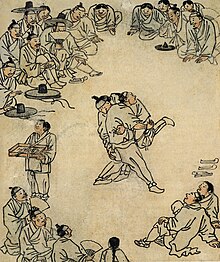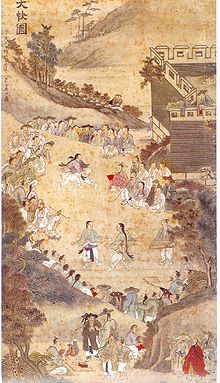Ssireum
| Korean spelling | |
|---|---|
| Korean alphabet : | 씨름 |
| Revised Romanization : | Ssireum |
| McCune-Reischauer : | Ssirŭm |

Ssireum ( kor. 씨름 ) is an ancient form of wrestling that is only common in Korea . The oldest surviving traces of the sport date back to the 4th century , but it is sometimes ascribed an age of up to 5,000 years. Today a modernized form is operated by both amateurs and semi-professionals.
Origin of the designation
Korean wrestling used to be known under various names such as Gakjo , Gakhi , Sangbak , Jaenggyo or Gakgi , although the exact origin of the word cannot yet be proven by reliable historical sources. In China it was called Koroyogi or Yogyo. The name Ssireum has been used since around 1920. The origin of the word is in the dark. According to one theory, it derives from the verb ssirunda , which means something like "show your physical strength in a duel", another leads it back to the word silum for the Mongolian bokhe wrestling.
history

The oldest depictions of the sport can be found on wall paintings in tombs from the time of the Goguryeo kingdom . It was practiced on the occasion of local festivals, but also on national secular and religious holidays. The fighting took place between the strongest young men in the surrounding villages. The winner was whoever stood on his feet last. He was given the title jangsa ("athlete" or "strong man") and he received a cow as prize money. During the Three Kingdoms Period (1st century BC - 7th century AD), Ssireum also became part of military hand-to-hand combat training.
Even during the occupation of Korea by Japan , ssireum was allowed to continue to be practiced , allegedly because of its similarity to sumo . The first sponsored competition was held in Seoul in 1912. As a result, competitions were held again and again. The Pan Joseon Ssireum Federation , the national umbrella organization at the time, hosted the first Pan Ssireum championships in 1936; from this the regular national championships developed. In the wake of the Asian crisis at the beginning of the 2000s and the associated withdrawal of sponsors, the Ssireum sport fell into a crisis and many athletes turned to other activities; To get more public attention again, the Korean Ssireum Association organized a six-day competition in which fighters from other nations also took part. In the meantime there are regularly numerous competitions for men and women in (South) Korea.
While the organizational structures in South Korea were created from scratch after 1953 , almost nothing is known about Ssireum in North Korea , whereby sport has been part of the intangible cultural heritage since 2018 . North and South Korea have jointly submitted the sport to UNESCO . Ssireum is the first world heritage site that was ascribed to both states.
Worldwide distribution
In September 2008, the World Ssireum Federation (WSF) was founded in South Korea . 29 countries were represented at this founding event , which took place in Busan . The association was officially registered around six months later, on March 25, 2009. Yoon Myung-Sik became the founding president. A few days later, the European Ssireum Association was founded in Vilnius, Lithuania .
regulate
The two opponents fight within a circle strewn with sand that is eight meters in diameter. With their ring trousers they wear satpa , a belt that is looped around the waist and thigh and on which handles can be attached like on a mawashi of the sumo ringer. The opponent must not let go of this satpa during the entire fight. The aim is to bring down the opponent through strength and skill. In contrast to sumo, a best of 3 is usually fought out so that a fight lasts at least two rounds. In these fights it is not allowed to hit or push. A round lasts, depending on the weight class, 2 to 3 minutes, for women one minute, whereby this time can also be extended or the round can be repeated if no winner could be determined within the regular framework. Ssireum has 55 techniques to defeat the opponent by fighting.
Modern exercise
With the industrial development of Korea, this type of wrestling has become a real sport. The practice was organized and regulated and the national championship Ssireum Changsa and numerous competitions throughout the country, including university sports . Three weight classes were introduced to make the competitions more balanced. Li Man-ki , a pre-eminent wrestler of the 1980s, played a significant role in increasing the sport's popularity over the past few decades . Today's K-1 fighter Choi Hong-man (2.18 m; 163 kg) was also very successful in this discipline, as was Kang Ho-dong , who won several national titles and is now a celebrated comedian in South Korea.
From June 7th to 9th, 2012 the first Ssireum World Championships took place in Busan. A year later, the third overseas Korean Ssireum championship was held in Frankfurt am Main with 150 participants from twenty countries. Mixed competitions were also held here.
At the end of 2019, the KBS channel , Joy of Ssireum , included a TV show on Ssireum for the first time in its program in order to meet the audience's interest.
Ssireum in entertainment media
Movie
- Like a Virgin - 2006 South Korean film about a woman who joins a Ssireum team for the chance of big prize money.
- The Art of Fighting - 2006 South Korean film about a student who learns sireum after being bullied at school.
- Yeongdeok Women's Wrestling Team - South Korean film from 2011 about a man who sets up a women's ssireum team to start with at a national tournament.
See also
literature
- Thomas A. Green, Joseph Svinth: Martial Arts of the World: An Encyclopedia of History and Innovation , 2 volumes, ABC-Clio, 2010, ISBN 978-1-59884-243-2
- Hendrik Rubbeling: Taekkyon - Like water and wind. Books on Demand, Norderstedt 2017, ISBN 978-3744896818 .
swell
- ↑ Christopher A. Sparks: Traditions and Play to develop community in Culture, Community, and Development , Routledge 2020, ISBN 978-0-429-95114-5
- ↑ koreancultureblog.com
- ↑ Thomas Green et al .: Martial Arts of the World, ABC-Clio, 2010, p. 193
- ↑ CNN Travel: Traditional Korean wrestling faces its toughest bout yet
- ↑ koreancultureblog.com
- ↑ Deutschlandfunk : Ssireum is a new Unesco World Heritage site , November 26, 2018.
- ↑ Yoon Min-sik: Ssireum becomes Koreas' 1st jointly inscribed UNESCO world heritage item. In: The Korea Herald . November 26, 2018, accessed November 26, 2018 .
- ↑ worldssireum.org
- ↑ worldsserium.org
- ^ Mixed sireum competition
- ↑ Traditional wrestling ssireum sees recent resurgence, korea.net

